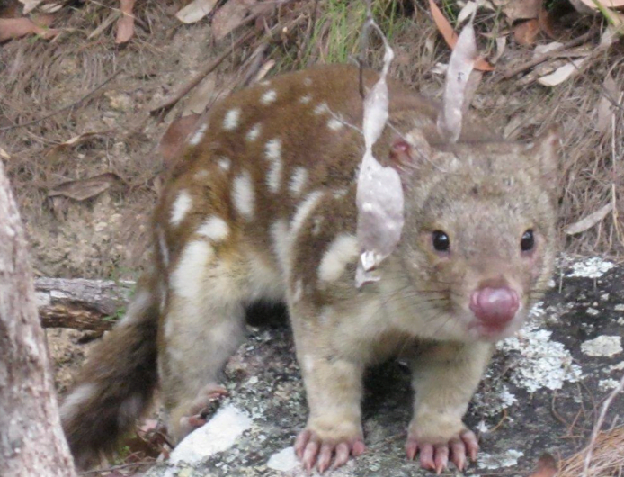Jen,
Have a look at the size of this male quoll we saw in Boonoo Boonoo National Park near Stanthorpe a few days ago.
It is currently mating season for quolls and he was quite aggressive as well as curious.

They are rare in southeastern Queensland these days. As you would know, these Dasyurus maculatus go by the common names of Spotted Tail Quoll, Tiger Quoll and Tiger Cat. Their habitat runs from southeastern Queensland to Tasmania with another sub-species up north.
An old bloke who lived in the New England ranges as a kid once told me that these male quolls would bale him up on his way to and from school and he was terrified of them.
When I saw this quoll, I initially thought it was a feral cat running behind a tree. But the feral morphed into this magnificent native cat when he appeared the other side.
A truly magic moment: Fair took my breath away.
Jim

 Jennifer Marohasy BSc PhD is a critical thinker with expertise in the scientific method.
Jennifer Marohasy BSc PhD is a critical thinker with expertise in the scientific method.

Jim, Magnificent photograph. Thanks so much for sharing.
********
And I should probably share with everyone this note received last week:
“Hi Jennifer, this is Richard Rivera at the National Oceanic and Atmospheric Administration. We are currently working on an article on Narwhal whales and it seems you might be one of a very small group of people that have pictures of Narwhal entrapments. I found your blog posting at
http://jennifermarohasy.com/2008/11/first-photograph-of-trapped-whales/
through a google search. We are very interested in using some of the images posted on that page and would love to know if you know the contact info. for the photographer or a way for us to be able to get these images ourselves.
Thank you in advance and I hope to hear from you soon.”
I did put Richard Rivera in contact with the photographer.
I should have said that the photo was taken by Dawn Hooper, one of a small group of birdos that explored the planet of granite between Stanthorpe and Tenterfield last week. We were rewarded with about 90 species in those frosty ranges. Lots of Superb Lyrebirds, Scarlet Robins, Bassian Thrushes etc.
Um, I’ve never seen a quoll before. How can I tell how big it is? Perhaps a common object could be placed next to it like a matchbox so I can compare.
An interesting thing that I recall in part of a TV report on quoll survival was that after some devastating bushfires down south here there was a fear that they would suffer from loss of their favourite food source; possums. (well locally anyway). No probs researchers found that they had changed their diet to rabbits; according to analysis of scats.
Of course, climate change will knock them off though because of lack of any adaptive capabilities
Who was that South Australian who built fox and cat proof fences to save native species and advocated having Quolls as domesticated pets in preference to cats.
John, yes I remember that bloke, he used to wear a “cat hat” made from a skinned feral cat.
Bob, WRT adaptive capabilities and CC I hope your tongue is firmly-in-cheek.
Ron, the spotteds are the biggest of the quolls and it’s a pity there isn’t much to compare it with size-wise except those gum leaves however I have read where they reach 7kg and gaugeing from dogs I am familiar with that weigh 12kg, this animal would have weighed at least 7kg if not more.
The “cat hat” man was John Womersley and he had a private zoo based on native fawna in the Adelaide Hills near Stirling called Warrawong Wildlife Sanctury. He also began developing a further native animal refuge property near Sedan in the lower River Murray Region. He is at least retired, and sold the business which still operates . We have been to it before (and observed his headwear), and since he retired where you can see lots of poterroos, bilbys and other small miniature kangaroo looking creatures hopping about. In the 1970s I think he was also intimately involved in an organisation called GROAP who liked gum trees along with a penchant for ring barking the odd penis radiata in the Hills area as their objective was closely linked to their organisation title which spells out as Get Rid Of All Pines.
My apologies Bob FJ, I realise now that your tongue was exactly where I said.
Yes – That’s the man Alan. I eagerly attended a meeting called by local developer Chum Vignan where he’d invited John Womersley to come and propose we turn his property in north Ocean Shores into a Wildlife Sanctury similar to the one in SA.
It never happened because everyone, including myself, were appalled at the rudeness and arrogance of John Wormsley.